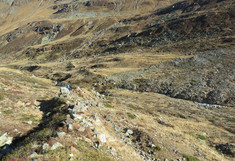Alpine glaciers react highly sensitive to climate variations and cause – due to fluctuations – geomorphological imprints in glacial and periglacial areas, e.g. glacial polish because of detersion, and distinct moraine sequences. Moraines at elevations below the modern ice margin mark stable glacier positions in the past and indicate wetter and colder climate conditions. Detailed mapping of these landforms allows putting spatial constraints on paleo-glacier positions. In addition, numerical ages, generated by applying cosmogenic surface exposure dating using 10Be, provide information with respect to depositional ages of moraines. With a combination of both approaches, geomorphological mapping and moraine dating, ice margins are reconstructed, thereby establishing a comprehensive geochronology of glacier advances and retreats at the Silvretta region covering the past 11.700 years, the Holocene. Results are implemented in a glacier model. The aim is to complement the traditional model calibration period, which is largely based on instrumental observations, with geological age data, in this way including the geological time scale in the model. In a next step, past glacier fluctuations will be reconstructed and interpreted towards a paleo-climatological context. This allows answering the question of environmental and climatological conditions necessary to produce mapped and dated moraines in the Silvretta region. If paleo-glacier positions can be modelled successfully, there are good chances to robustly estimate future glacier change implied by predicted climate scenarios, and to provide a framework to assess effects of glacier and climate change in the Silvretta region. The research project is centered at BOKU’s Institute of Applied Geology and is realized in collaboration with our international and national collaborators: Lamont-Doherty Earth Observatory (NY, USA), University of Utah (UT, USA), and the Geological Survey of Austria (AUT). Ph.D. student Sandra Braumann is funded by the Austrian Academy of Sciences’ DOC scholarship and is participating in BOKU’s ‘Transition to Sustainability’ (T2S) Doctoral School. Inatura Erlebnis Naturschau GmbH at Dornbirn generously sponsors the project in coordination with the provincial government (Amt der Vorarlberger Landesregierung, AbT. IVe).


